Evaluating Contemporary Themes in UK CHD Healthcare Practice
VerifiedAdded on 2021/04/17
|17
|4813
|34
Essay
AI Summary
This essay provides a critical evaluation of contemporary themes in the management of Coronary Heart Disease (CHD) in the UK, drawing on six journal articles. It explores various aspects of CHD management, including tobacco control policies, salt reduction strategies, dietary guidelines, and primary and secondary prevention approaches. The essay analyzes the effectiveness of these policies, linking them to relevant management theories and leadership frameworks, such as the contingency approach and change management theory. The analysis covers the impact of tobacco control on smoking prevalence and CHD mortality, the economic evaluation of salt reduction policies, and the role of dietary recommendations in preventing cardiovascular disease. Furthermore, the essay examines the impact of primary and secondary prevention strategies on population health and identifies areas for improvement in healthcare management practices targeting CVD. It also includes a discussion of leadership theories in the context of health management. The essay emphasizes the importance of stakeholder analysis, stricter legislation, and constant monitoring to improve CHD management and reduce the burden of cardiovascular diseases in the UK. The essay concludes with recommendations for enhancing healthcare management practices to improve outcomes related to cardiovascular disease.
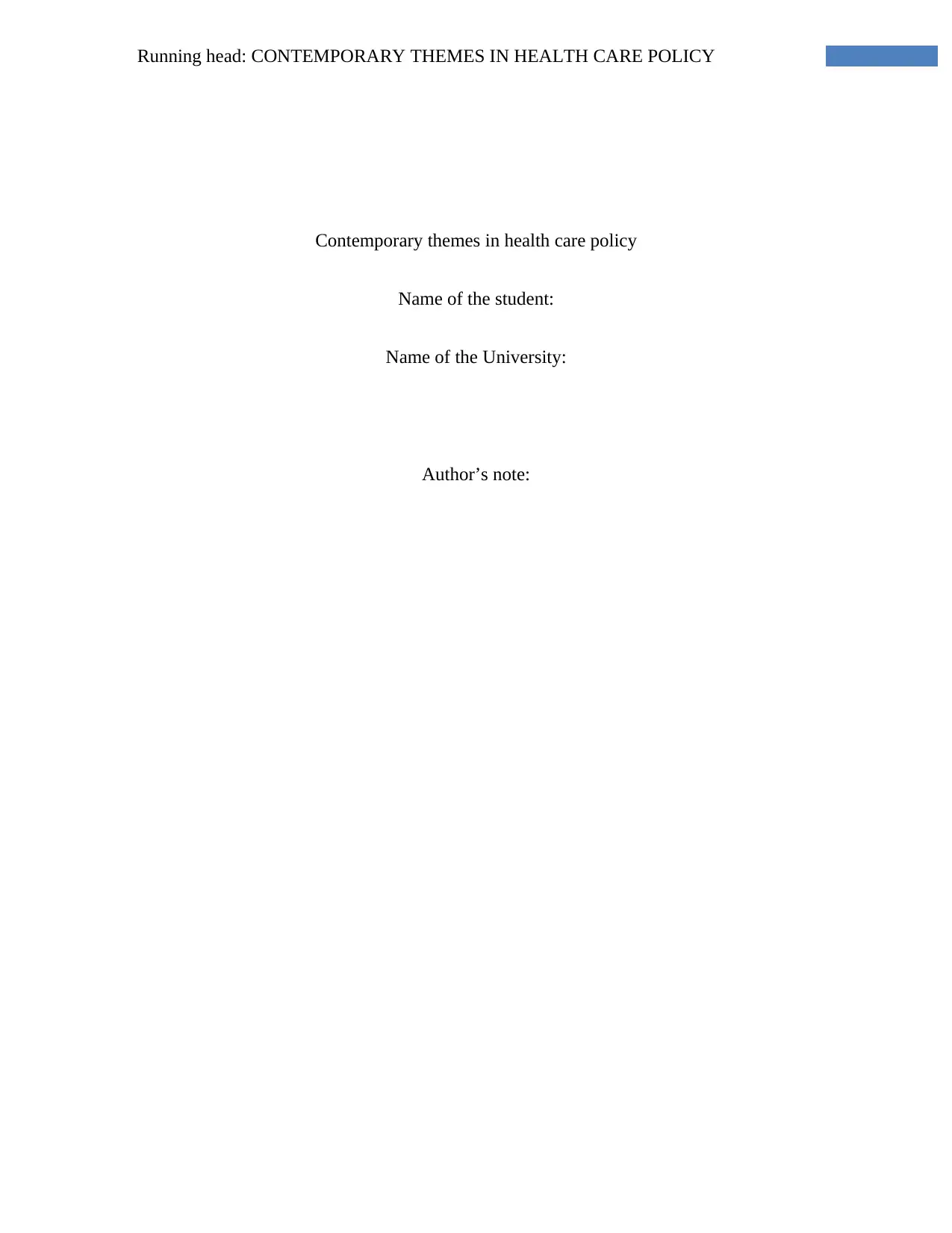
Running head: CONTEMPORARY THEMES IN HEALTH CARE POLICY
Contemporary themes in health care policy
Name of the student:
Name of the University:
Author’s note:
Contemporary themes in health care policy
Name of the student:
Name of the University:
Author’s note:
Paraphrase This Document
Need a fresh take? Get an instant paraphrase of this document with our AI Paraphraser
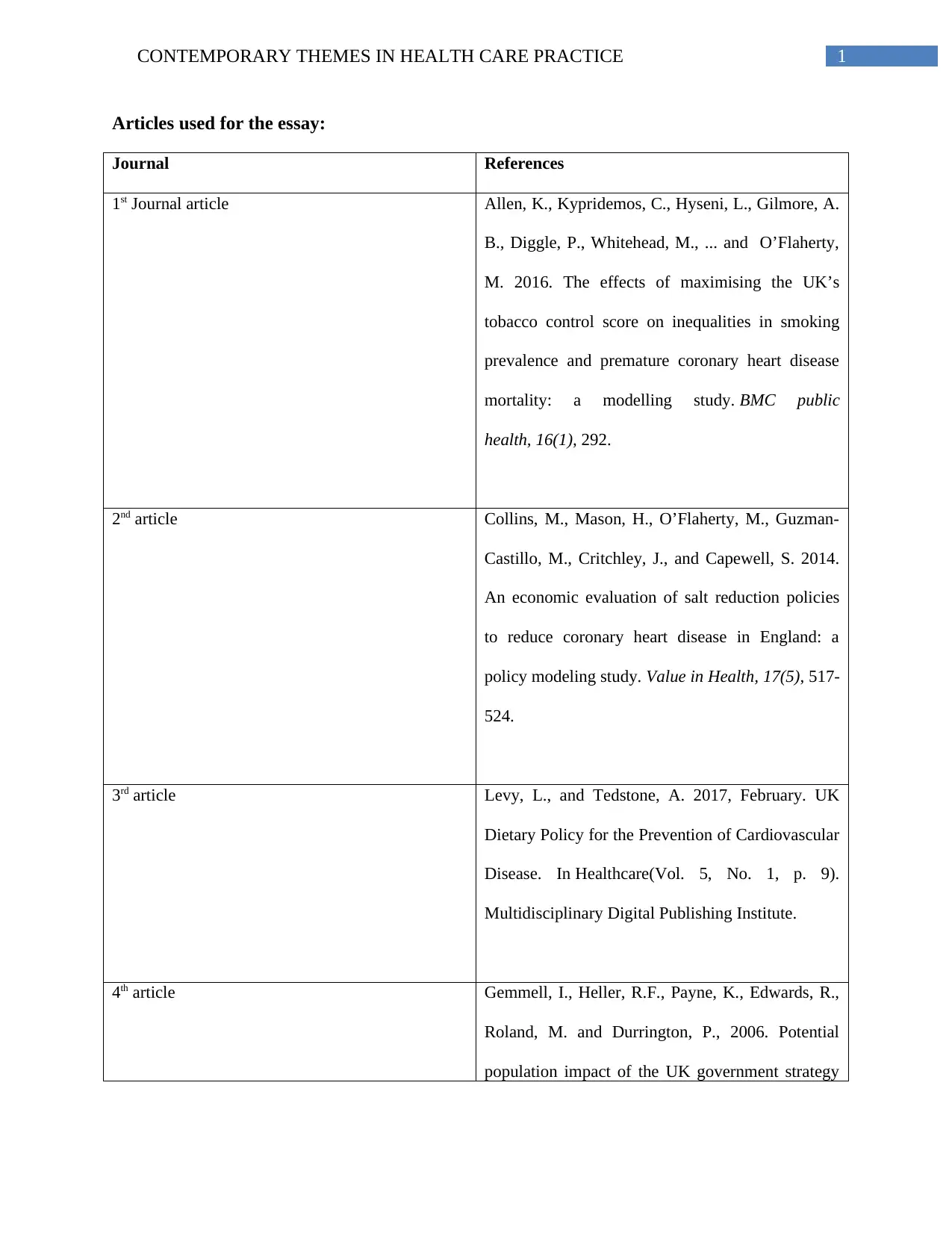
1CONTEMPORARY THEMES IN HEALTH CARE PRACTICE
Articles used for the essay:
Journal References
1st Journal article Allen, K., Kypridemos, C., Hyseni, L., Gilmore, A.
B., Diggle, P., Whitehead, M., ... and O’Flaherty,
M. 2016. The effects of maximising the UK’s
tobacco control score on inequalities in smoking
prevalence and premature coronary heart disease
mortality: a modelling study. BMC public
health, 16(1), 292.
2nd article Collins, M., Mason, H., O’Flaherty, M., Guzman-
Castillo, M., Critchley, J., and Capewell, S. 2014.
An economic evaluation of salt reduction policies
to reduce coronary heart disease in England: a
policy modeling study. Value in Health, 17(5), 517-
524.
3rd article Levy, L., and Tedstone, A. 2017, February. UK
Dietary Policy for the Prevention of Cardiovascular
Disease. In Healthcare(Vol. 5, No. 1, p. 9).
Multidisciplinary Digital Publishing Institute.
4th article Gemmell, I., Heller, R.F., Payne, K., Edwards, R.,
Roland, M. and Durrington, P., 2006. Potential
population impact of the UK government strategy
Articles used for the essay:
Journal References
1st Journal article Allen, K., Kypridemos, C., Hyseni, L., Gilmore, A.
B., Diggle, P., Whitehead, M., ... and O’Flaherty,
M. 2016. The effects of maximising the UK’s
tobacco control score on inequalities in smoking
prevalence and premature coronary heart disease
mortality: a modelling study. BMC public
health, 16(1), 292.
2nd article Collins, M., Mason, H., O’Flaherty, M., Guzman-
Castillo, M., Critchley, J., and Capewell, S. 2014.
An economic evaluation of salt reduction policies
to reduce coronary heart disease in England: a
policy modeling study. Value in Health, 17(5), 517-
524.
3rd article Levy, L., and Tedstone, A. 2017, February. UK
Dietary Policy for the Prevention of Cardiovascular
Disease. In Healthcare(Vol. 5, No. 1, p. 9).
Multidisciplinary Digital Publishing Institute.
4th article Gemmell, I., Heller, R.F., Payne, K., Edwards, R.,
Roland, M. and Durrington, P., 2006. Potential
population impact of the UK government strategy
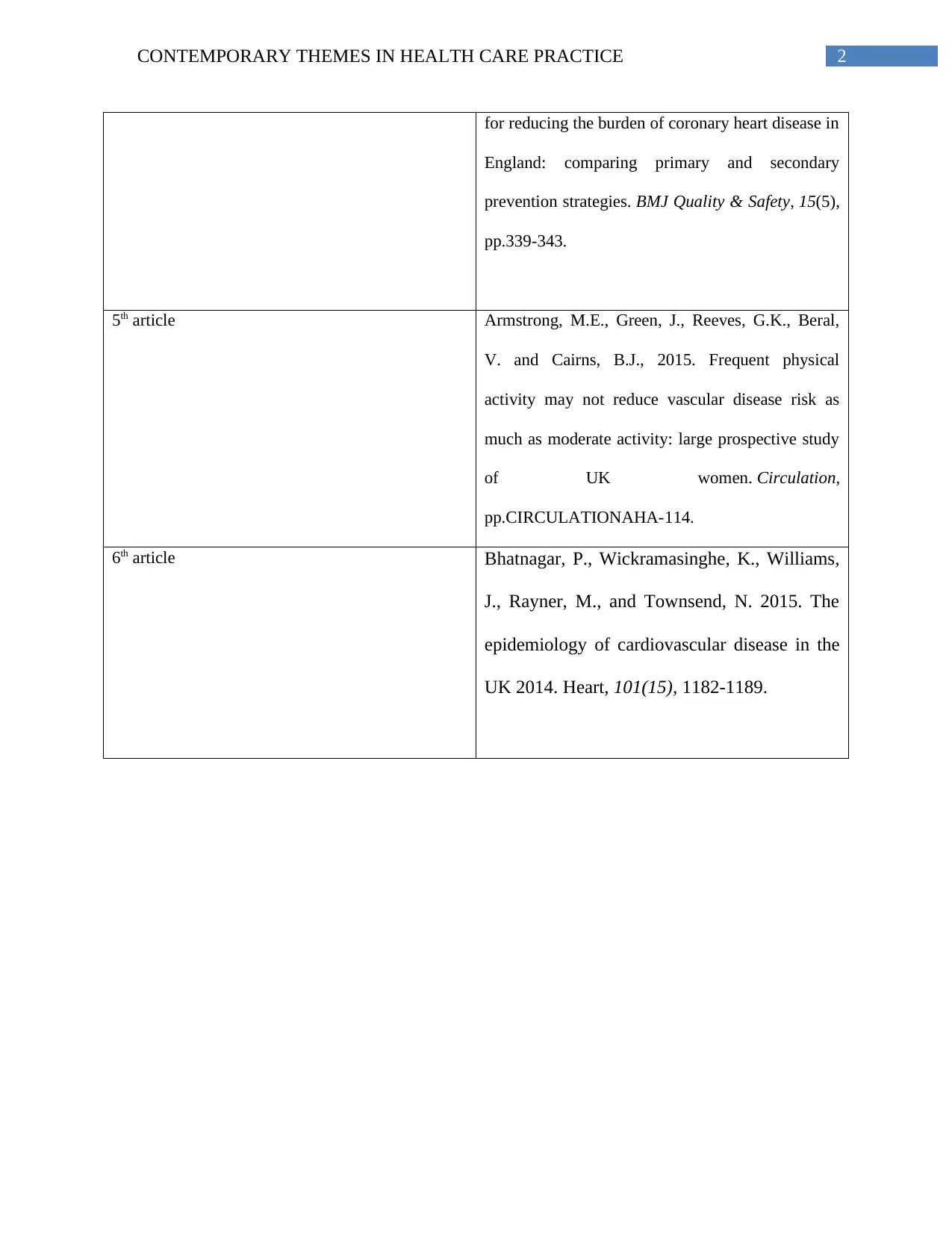
2CONTEMPORARY THEMES IN HEALTH CARE PRACTICE
for reducing the burden of coronary heart disease in
England: comparing primary and secondary
prevention strategies. BMJ Quality & Safety, 15(5),
pp.339-343.
5th article Armstrong, M.E., Green, J., Reeves, G.K., Beral,
V. and Cairns, B.J., 2015. Frequent physical
activity may not reduce vascular disease risk as
much as moderate activity: large prospective study
of UK women. Circulation,
pp.CIRCULATIONAHA-114.
6th article Bhatnagar, P., Wickramasinghe, K., Williams,
J., Rayner, M., and Townsend, N. 2015. The
epidemiology of cardiovascular disease in the
UK 2014. Heart, 101(15), 1182-1189.
for reducing the burden of coronary heart disease in
England: comparing primary and secondary
prevention strategies. BMJ Quality & Safety, 15(5),
pp.339-343.
5th article Armstrong, M.E., Green, J., Reeves, G.K., Beral,
V. and Cairns, B.J., 2015. Frequent physical
activity may not reduce vascular disease risk as
much as moderate activity: large prospective study
of UK women. Circulation,
pp.CIRCULATIONAHA-114.
6th article Bhatnagar, P., Wickramasinghe, K., Williams,
J., Rayner, M., and Townsend, N. 2015. The
epidemiology of cardiovascular disease in the
UK 2014. Heart, 101(15), 1182-1189.
⊘ This is a preview!⊘
Do you want full access?
Subscribe today to unlock all pages.

Trusted by 1+ million students worldwide

3CONTEMPORARY THEMES IN HEALTH CARE PRACTICE
Cardiovascular diseases (CVD) are one of the leading causes of death worldwide. The
prevalence of cardiovascular disease has been associated with many management challenges for
the health care sector due to the high rate of mortality and morbidity associated with the
diagnosis of the condition. The significance of the issue is understood from alarming 2015 global
statistics that CVD represents 31% of all global deaths and out of this 7.4 million were caused by
coronary heart disease (CHD) (World Health Organization, 2015). CHD is a type of heart
disease associated with narrowing of the coronary arteries and blood vessels that affects the
supply of blood to the heart. It is the most common type of heart disease and one of the leading
cause of death in UK. Nearly one in every seven men and one in every twelve women die from
CHD in UK and the number of deaths annually is about 66,000 (Bhf.org.uk, 2016). UK
government is also dealing with the rise in deaths from CHD and the number of people living
with the condition and implemented many intervention and preventive programs to reduce the
rate of CHD. Due to such statistics on incidence of CHD in UK, it is necessary to evaluate
preventive work done for CHD in UK by linking it with appropriate management theories,
leadership framework and management of change. Hence, the main purpose of this essay is to
identify and critically evaluate 6 articles related to the management of CHD in UK and then
present recommendation for improving health care management practices targeting CVD.
The first article that covered the topic of management of CHD in UK includes the article
by Allen et al. (2016) which focused on estimating the cumulative effect of tobacco control
policies in UK on smoking prevalence and premature CHD related mortality. Six different
types of policy were evaluated in the study and the IMPACT (International Model for Policy
Analysis of Agricultural Commodities and Trade) Policy model was used to link changes
associated with policies to smoking prevalence and CHD and with the use of this model, the
Cardiovascular diseases (CVD) are one of the leading causes of death worldwide. The
prevalence of cardiovascular disease has been associated with many management challenges for
the health care sector due to the high rate of mortality and morbidity associated with the
diagnosis of the condition. The significance of the issue is understood from alarming 2015 global
statistics that CVD represents 31% of all global deaths and out of this 7.4 million were caused by
coronary heart disease (CHD) (World Health Organization, 2015). CHD is a type of heart
disease associated with narrowing of the coronary arteries and blood vessels that affects the
supply of blood to the heart. It is the most common type of heart disease and one of the leading
cause of death in UK. Nearly one in every seven men and one in every twelve women die from
CHD in UK and the number of deaths annually is about 66,000 (Bhf.org.uk, 2016). UK
government is also dealing with the rise in deaths from CHD and the number of people living
with the condition and implemented many intervention and preventive programs to reduce the
rate of CHD. Due to such statistics on incidence of CHD in UK, it is necessary to evaluate
preventive work done for CHD in UK by linking it with appropriate management theories,
leadership framework and management of change. Hence, the main purpose of this essay is to
identify and critically evaluate 6 articles related to the management of CHD in UK and then
present recommendation for improving health care management practices targeting CVD.
The first article that covered the topic of management of CHD in UK includes the article
by Allen et al. (2016) which focused on estimating the cumulative effect of tobacco control
policies in UK on smoking prevalence and premature CHD related mortality. Six different
types of policy were evaluated in the study and the IMPACT (International Model for Policy
Analysis of Agricultural Commodities and Trade) Policy model was used to link changes
associated with policies to smoking prevalence and CHD and with the use of this model, the
Paraphrase This Document
Need a fresh take? Get an instant paraphrase of this document with our AI Paraphraser
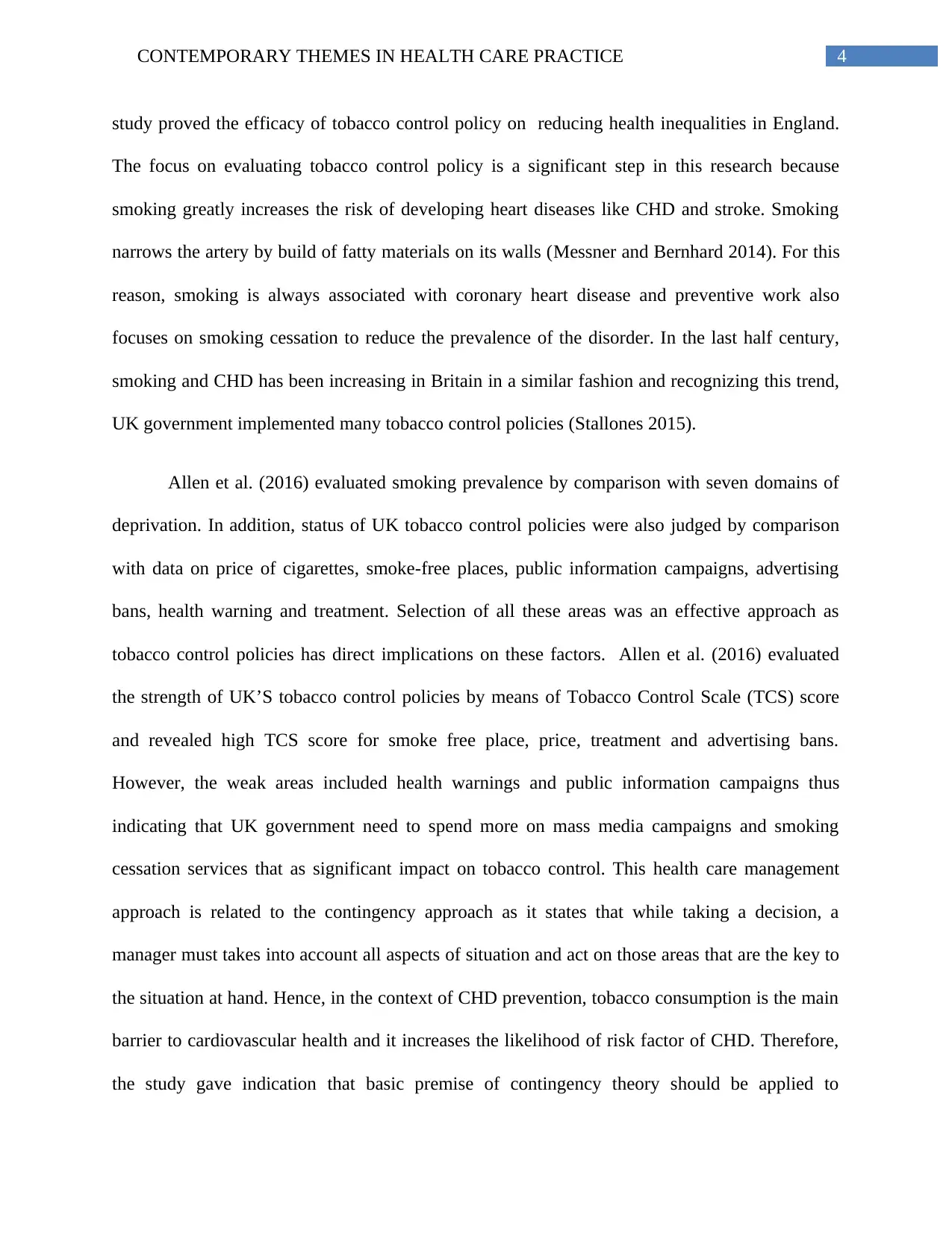
4CONTEMPORARY THEMES IN HEALTH CARE PRACTICE
study proved the efficacy of tobacco control policy on reducing health inequalities in England.
The focus on evaluating tobacco control policy is a significant step in this research because
smoking greatly increases the risk of developing heart diseases like CHD and stroke. Smoking
narrows the artery by build of fatty materials on its walls (Messner and Bernhard 2014). For this
reason, smoking is always associated with coronary heart disease and preventive work also
focuses on smoking cessation to reduce the prevalence of the disorder. In the last half century,
smoking and CHD has been increasing in Britain in a similar fashion and recognizing this trend,
UK government implemented many tobacco control policies (Stallones 2015).
Allen et al. (2016) evaluated smoking prevalence by comparison with seven domains of
deprivation. In addition, status of UK tobacco control policies were also judged by comparison
with data on price of cigarettes, smoke-free places, public information campaigns, advertising
bans, health warning and treatment. Selection of all these areas was an effective approach as
tobacco control policies has direct implications on these factors. Allen et al. (2016) evaluated
the strength of UK’S tobacco control policies by means of Tobacco Control Scale (TCS) score
and revealed high TCS score for smoke free place, price, treatment and advertising bans.
However, the weak areas included health warnings and public information campaigns thus
indicating that UK government need to spend more on mass media campaigns and smoking
cessation services that as significant impact on tobacco control. This health care management
approach is related to the contingency approach as it states that while taking a decision, a
manager must takes into account all aspects of situation and act on those areas that are the key to
the situation at hand. Hence, in the context of CHD prevention, tobacco consumption is the main
barrier to cardiovascular health and it increases the likelihood of risk factor of CHD. Therefore,
the study gave indication that basic premise of contingency theory should be applied to
study proved the efficacy of tobacco control policy on reducing health inequalities in England.
The focus on evaluating tobacco control policy is a significant step in this research because
smoking greatly increases the risk of developing heart diseases like CHD and stroke. Smoking
narrows the artery by build of fatty materials on its walls (Messner and Bernhard 2014). For this
reason, smoking is always associated with coronary heart disease and preventive work also
focuses on smoking cessation to reduce the prevalence of the disorder. In the last half century,
smoking and CHD has been increasing in Britain in a similar fashion and recognizing this trend,
UK government implemented many tobacco control policies (Stallones 2015).
Allen et al. (2016) evaluated smoking prevalence by comparison with seven domains of
deprivation. In addition, status of UK tobacco control policies were also judged by comparison
with data on price of cigarettes, smoke-free places, public information campaigns, advertising
bans, health warning and treatment. Selection of all these areas was an effective approach as
tobacco control policies has direct implications on these factors. Allen et al. (2016) evaluated
the strength of UK’S tobacco control policies by means of Tobacco Control Scale (TCS) score
and revealed high TCS score for smoke free place, price, treatment and advertising bans.
However, the weak areas included health warnings and public information campaigns thus
indicating that UK government need to spend more on mass media campaigns and smoking
cessation services that as significant impact on tobacco control. This health care management
approach is related to the contingency approach as it states that while taking a decision, a
manager must takes into account all aspects of situation and act on those areas that are the key to
the situation at hand. Hence, in the context of CHD prevention, tobacco consumption is the main
barrier to cardiovascular health and it increases the likelihood of risk factor of CHD. Therefore,
the study gave indication that basic premise of contingency theory should be applied to
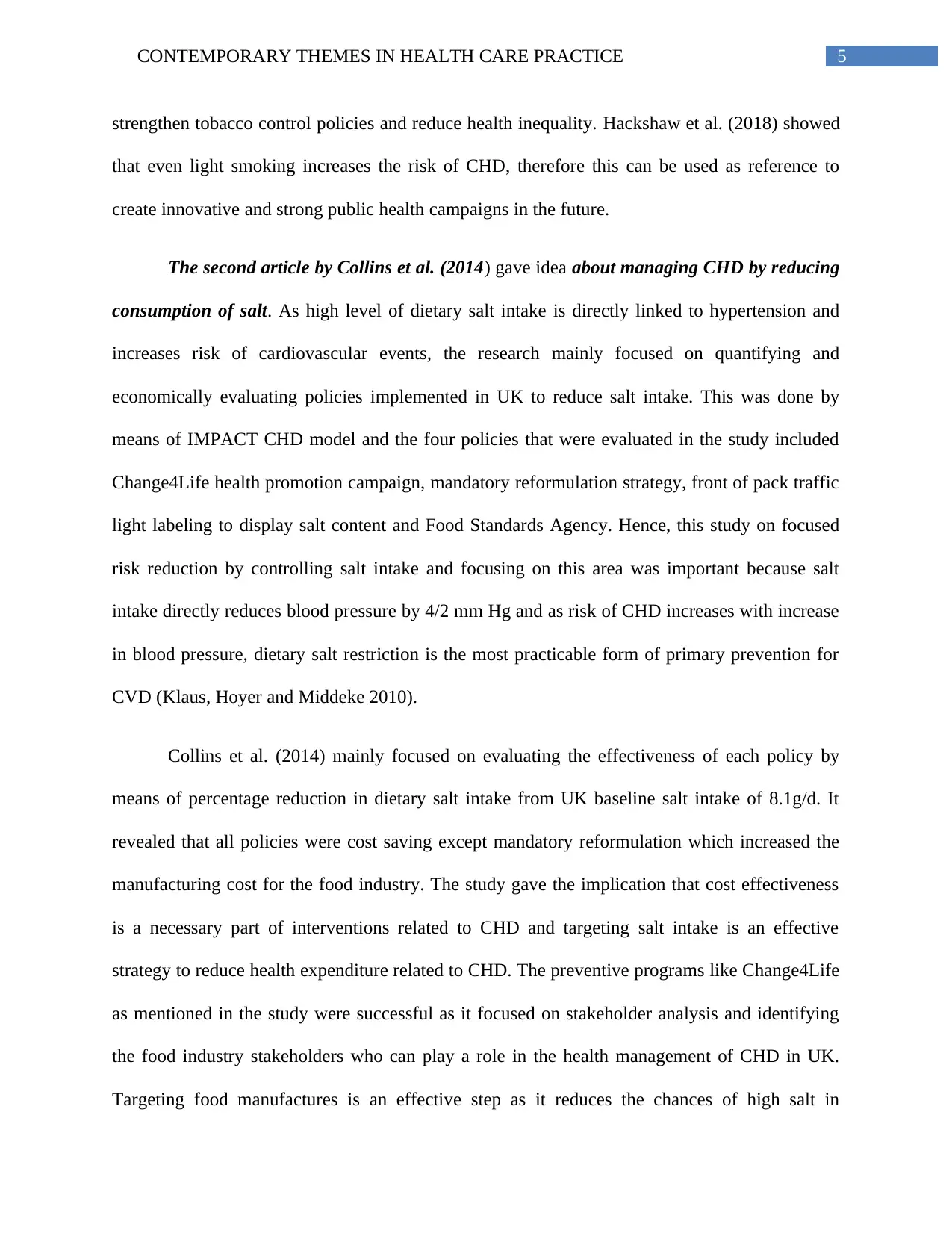
5CONTEMPORARY THEMES IN HEALTH CARE PRACTICE
strengthen tobacco control policies and reduce health inequality. Hackshaw et al. (2018) showed
that even light smoking increases the risk of CHD, therefore this can be used as reference to
create innovative and strong public health campaigns in the future.
The second article by Collins et al. (2014) gave idea about managing CHD by reducing
consumption of salt. As high level of dietary salt intake is directly linked to hypertension and
increases risk of cardiovascular events, the research mainly focused on quantifying and
economically evaluating policies implemented in UK to reduce salt intake. This was done by
means of IMPACT CHD model and the four policies that were evaluated in the study included
Change4Life health promotion campaign, mandatory reformulation strategy, front of pack traffic
light labeling to display salt content and Food Standards Agency. Hence, this study on focused
risk reduction by controlling salt intake and focusing on this area was important because salt
intake directly reduces blood pressure by 4/2 mm Hg and as risk of CHD increases with increase
in blood pressure, dietary salt restriction is the most practicable form of primary prevention for
CVD (Klaus, Hoyer and Middeke 2010).
Collins et al. (2014) mainly focused on evaluating the effectiveness of each policy by
means of percentage reduction in dietary salt intake from UK baseline salt intake of 8.1g/d. It
revealed that all policies were cost saving except mandatory reformulation which increased the
manufacturing cost for the food industry. The study gave the implication that cost effectiveness
is a necessary part of interventions related to CHD and targeting salt intake is an effective
strategy to reduce health expenditure related to CHD. The preventive programs like Change4Life
as mentioned in the study were successful as it focused on stakeholder analysis and identifying
the food industry stakeholders who can play a role in the health management of CHD in UK.
Targeting food manufactures is an effective step as it reduces the chances of high salt in
strengthen tobacco control policies and reduce health inequality. Hackshaw et al. (2018) showed
that even light smoking increases the risk of CHD, therefore this can be used as reference to
create innovative and strong public health campaigns in the future.
The second article by Collins et al. (2014) gave idea about managing CHD by reducing
consumption of salt. As high level of dietary salt intake is directly linked to hypertension and
increases risk of cardiovascular events, the research mainly focused on quantifying and
economically evaluating policies implemented in UK to reduce salt intake. This was done by
means of IMPACT CHD model and the four policies that were evaluated in the study included
Change4Life health promotion campaign, mandatory reformulation strategy, front of pack traffic
light labeling to display salt content and Food Standards Agency. Hence, this study on focused
risk reduction by controlling salt intake and focusing on this area was important because salt
intake directly reduces blood pressure by 4/2 mm Hg and as risk of CHD increases with increase
in blood pressure, dietary salt restriction is the most practicable form of primary prevention for
CVD (Klaus, Hoyer and Middeke 2010).
Collins et al. (2014) mainly focused on evaluating the effectiveness of each policy by
means of percentage reduction in dietary salt intake from UK baseline salt intake of 8.1g/d. It
revealed that all policies were cost saving except mandatory reformulation which increased the
manufacturing cost for the food industry. The study gave the implication that cost effectiveness
is a necessary part of interventions related to CHD and targeting salt intake is an effective
strategy to reduce health expenditure related to CHD. The preventive programs like Change4Life
as mentioned in the study were successful as it focused on stakeholder analysis and identifying
the food industry stakeholders who can play a role in the health management of CHD in UK.
Targeting food manufactures is an effective step as it reduces the chances of high salt in
⊘ This is a preview!⊘
Do you want full access?
Subscribe today to unlock all pages.

Trusted by 1+ million students worldwide
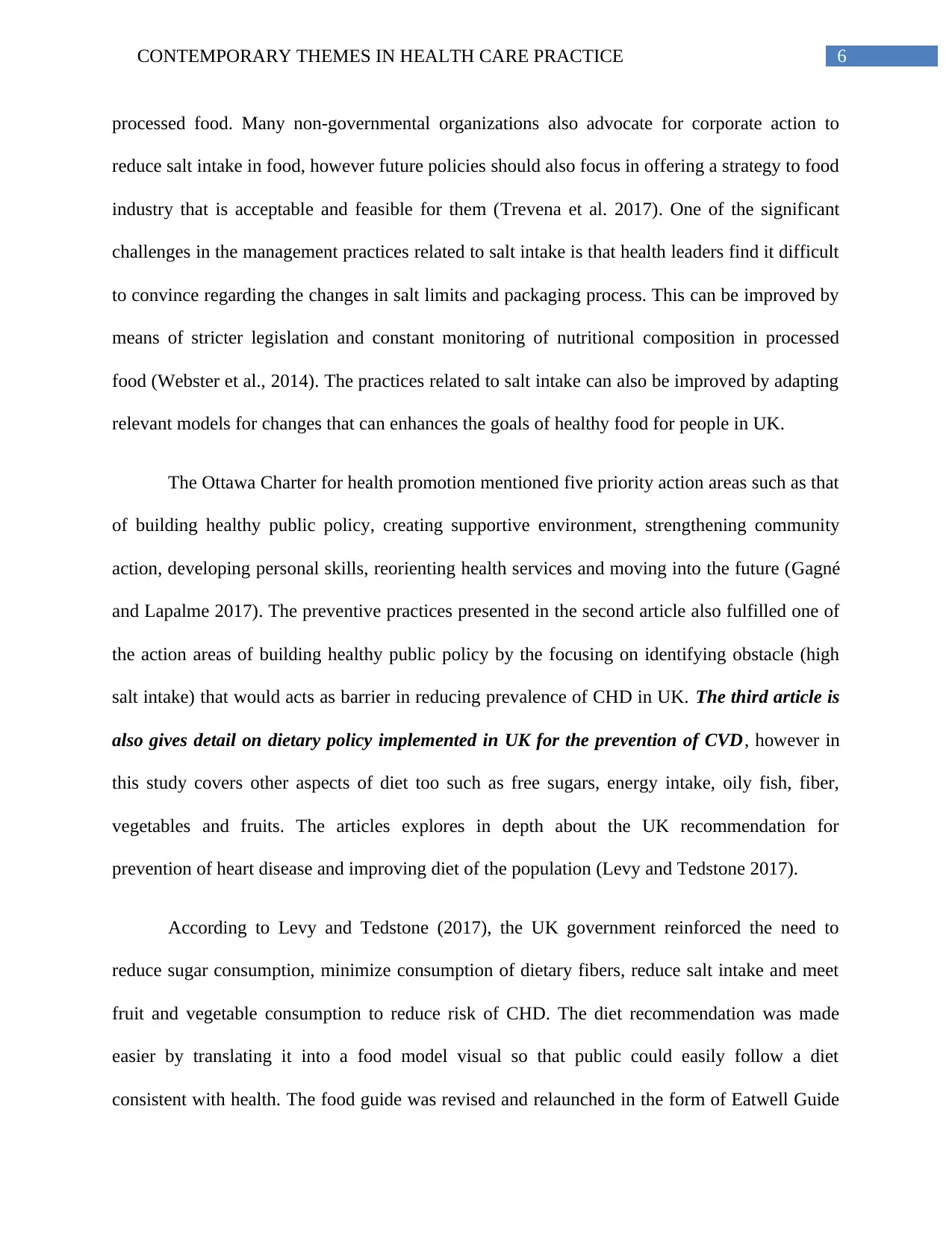
6CONTEMPORARY THEMES IN HEALTH CARE PRACTICE
processed food. Many non-governmental organizations also advocate for corporate action to
reduce salt intake in food, however future policies should also focus in offering a strategy to food
industry that is acceptable and feasible for them (Trevena et al. 2017). One of the significant
challenges in the management practices related to salt intake is that health leaders find it difficult
to convince regarding the changes in salt limits and packaging process. This can be improved by
means of stricter legislation and constant monitoring of nutritional composition in processed
food (Webster et al., 2014). The practices related to salt intake can also be improved by adapting
relevant models for changes that can enhances the goals of healthy food for people in UK.
The Ottawa Charter for health promotion mentioned five priority action areas such as that
of building healthy public policy, creating supportive environment, strengthening community
action, developing personal skills, reorienting health services and moving into the future (Gagné
and Lapalme 2017). The preventive practices presented in the second article also fulfilled one of
the action areas of building healthy public policy by the focusing on identifying obstacle (high
salt intake) that would acts as barrier in reducing prevalence of CHD in UK. The third article is
also gives detail on dietary policy implemented in UK for the prevention of CVD, however in
this study covers other aspects of diet too such as free sugars, energy intake, oily fish, fiber,
vegetables and fruits. The articles explores in depth about the UK recommendation for
prevention of heart disease and improving diet of the population (Levy and Tedstone 2017).
According to Levy and Tedstone (2017), the UK government reinforced the need to
reduce sugar consumption, minimize consumption of dietary fibers, reduce salt intake and meet
fruit and vegetable consumption to reduce risk of CHD. The diet recommendation was made
easier by translating it into a food model visual so that public could easily follow a diet
consistent with health. The food guide was revised and relaunched in the form of Eatwell Guide
processed food. Many non-governmental organizations also advocate for corporate action to
reduce salt intake in food, however future policies should also focus in offering a strategy to food
industry that is acceptable and feasible for them (Trevena et al. 2017). One of the significant
challenges in the management practices related to salt intake is that health leaders find it difficult
to convince regarding the changes in salt limits and packaging process. This can be improved by
means of stricter legislation and constant monitoring of nutritional composition in processed
food (Webster et al., 2014). The practices related to salt intake can also be improved by adapting
relevant models for changes that can enhances the goals of healthy food for people in UK.
The Ottawa Charter for health promotion mentioned five priority action areas such as that
of building healthy public policy, creating supportive environment, strengthening community
action, developing personal skills, reorienting health services and moving into the future (Gagné
and Lapalme 2017). The preventive practices presented in the second article also fulfilled one of
the action areas of building healthy public policy by the focusing on identifying obstacle (high
salt intake) that would acts as barrier in reducing prevalence of CHD in UK. The third article is
also gives detail on dietary policy implemented in UK for the prevention of CVD, however in
this study covers other aspects of diet too such as free sugars, energy intake, oily fish, fiber,
vegetables and fruits. The articles explores in depth about the UK recommendation for
prevention of heart disease and improving diet of the population (Levy and Tedstone 2017).
According to Levy and Tedstone (2017), the UK government reinforced the need to
reduce sugar consumption, minimize consumption of dietary fibers, reduce salt intake and meet
fruit and vegetable consumption to reduce risk of CHD. The diet recommendation was made
easier by translating it into a food model visual so that public could easily follow a diet
consistent with health. The food guide was revised and relaunched in the form of Eatwell Guide
Paraphrase This Document
Need a fresh take? Get an instant paraphrase of this document with our AI Paraphraser
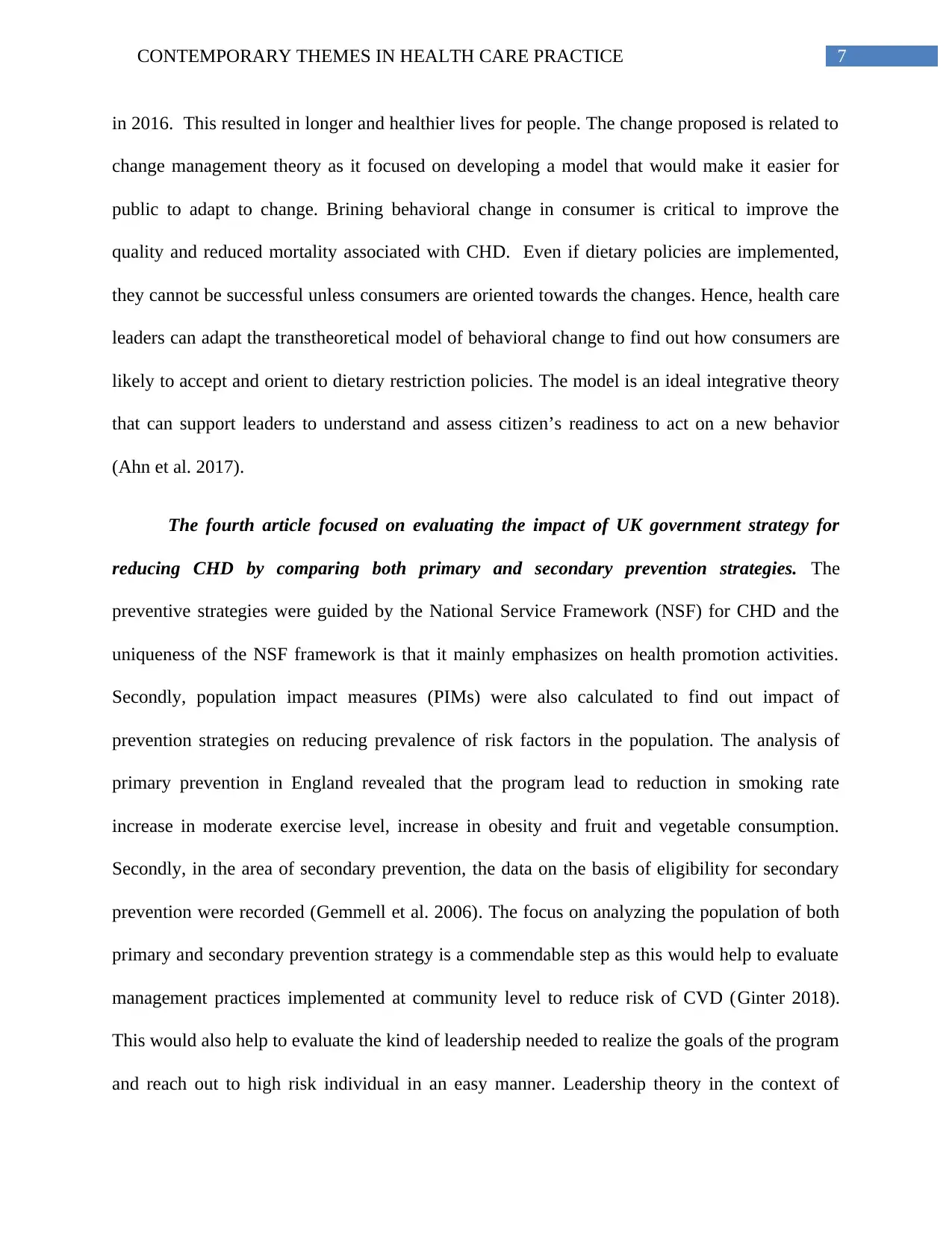
7CONTEMPORARY THEMES IN HEALTH CARE PRACTICE
in 2016. This resulted in longer and healthier lives for people. The change proposed is related to
change management theory as it focused on developing a model that would make it easier for
public to adapt to change. Brining behavioral change in consumer is critical to improve the
quality and reduced mortality associated with CHD. Even if dietary policies are implemented,
they cannot be successful unless consumers are oriented towards the changes. Hence, health care
leaders can adapt the transtheoretical model of behavioral change to find out how consumers are
likely to accept and orient to dietary restriction policies. The model is an ideal integrative theory
that can support leaders to understand and assess citizen’s readiness to act on a new behavior
(Ahn et al. 2017).
The fourth article focused on evaluating the impact of UK government strategy for
reducing CHD by comparing both primary and secondary prevention strategies. The
preventive strategies were guided by the National Service Framework (NSF) for CHD and the
uniqueness of the NSF framework is that it mainly emphasizes on health promotion activities.
Secondly, population impact measures (PIMs) were also calculated to find out impact of
prevention strategies on reducing prevalence of risk factors in the population. The analysis of
primary prevention in England revealed that the program lead to reduction in smoking rate
increase in moderate exercise level, increase in obesity and fruit and vegetable consumption.
Secondly, in the area of secondary prevention, the data on the basis of eligibility for secondary
prevention were recorded (Gemmell et al. 2006). The focus on analyzing the population of both
primary and secondary prevention strategy is a commendable step as this would help to evaluate
management practices implemented at community level to reduce risk of CVD (Ginter 2018).
This would also help to evaluate the kind of leadership needed to realize the goals of the program
and reach out to high risk individual in an easy manner. Leadership theory in the context of
in 2016. This resulted in longer and healthier lives for people. The change proposed is related to
change management theory as it focused on developing a model that would make it easier for
public to adapt to change. Brining behavioral change in consumer is critical to improve the
quality and reduced mortality associated with CHD. Even if dietary policies are implemented,
they cannot be successful unless consumers are oriented towards the changes. Hence, health care
leaders can adapt the transtheoretical model of behavioral change to find out how consumers are
likely to accept and orient to dietary restriction policies. The model is an ideal integrative theory
that can support leaders to understand and assess citizen’s readiness to act on a new behavior
(Ahn et al. 2017).
The fourth article focused on evaluating the impact of UK government strategy for
reducing CHD by comparing both primary and secondary prevention strategies. The
preventive strategies were guided by the National Service Framework (NSF) for CHD and the
uniqueness of the NSF framework is that it mainly emphasizes on health promotion activities.
Secondly, population impact measures (PIMs) were also calculated to find out impact of
prevention strategies on reducing prevalence of risk factors in the population. The analysis of
primary prevention in England revealed that the program lead to reduction in smoking rate
increase in moderate exercise level, increase in obesity and fruit and vegetable consumption.
Secondly, in the area of secondary prevention, the data on the basis of eligibility for secondary
prevention were recorded (Gemmell et al. 2006). The focus on analyzing the population of both
primary and secondary prevention strategy is a commendable step as this would help to evaluate
management practices implemented at community level to reduce risk of CVD (Ginter 2018).
This would also help to evaluate the kind of leadership needed to realize the goals of the program
and reach out to high risk individual in an easy manner. Leadership theory in the context of
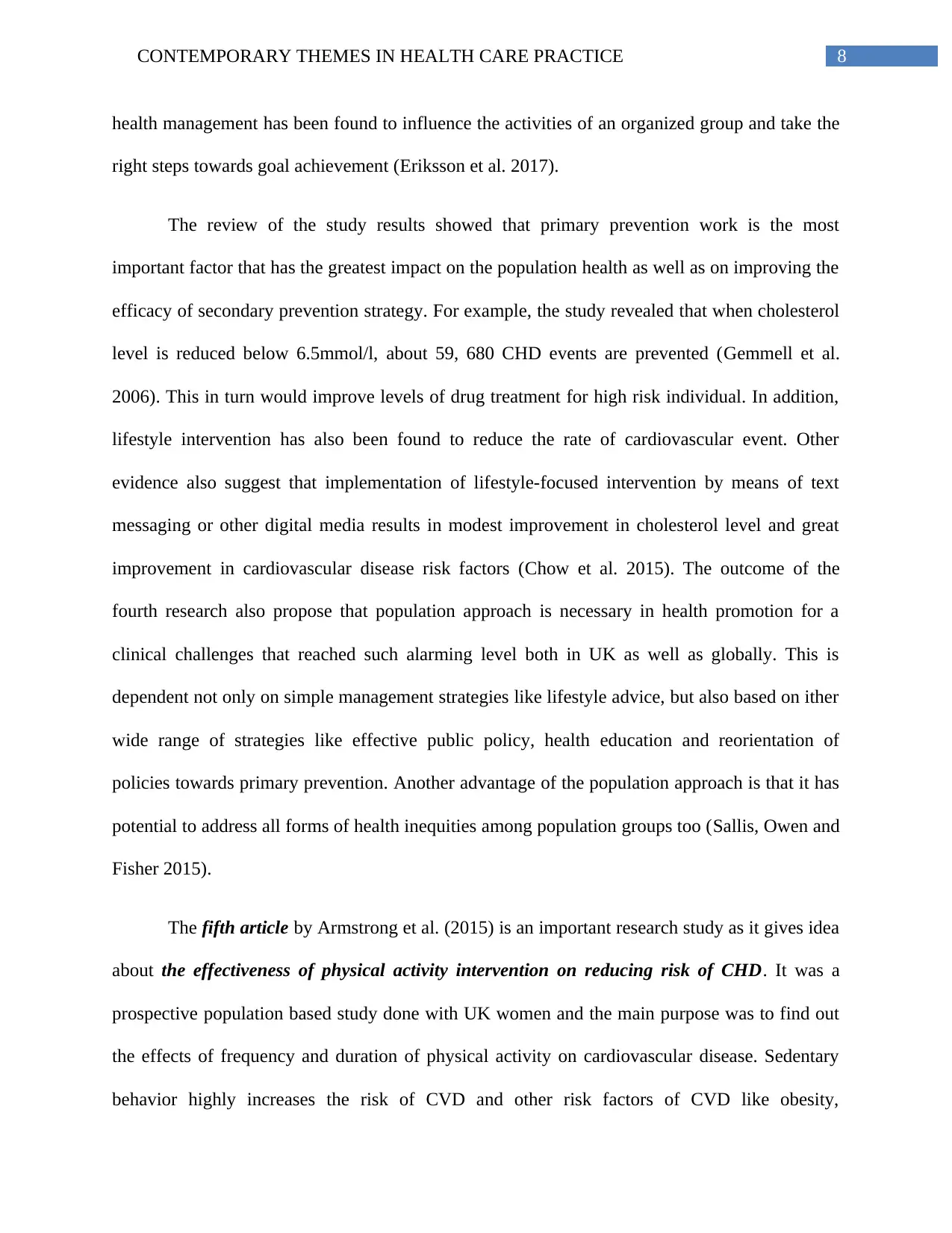
8CONTEMPORARY THEMES IN HEALTH CARE PRACTICE
health management has been found to influence the activities of an organized group and take the
right steps towards goal achievement (Eriksson et al. 2017).
The review of the study results showed that primary prevention work is the most
important factor that has the greatest impact on the population health as well as on improving the
efficacy of secondary prevention strategy. For example, the study revealed that when cholesterol
level is reduced below 6.5mmol/l, about 59, 680 CHD events are prevented (Gemmell et al.
2006). This in turn would improve levels of drug treatment for high risk individual. In addition,
lifestyle intervention has also been found to reduce the rate of cardiovascular event. Other
evidence also suggest that implementation of lifestyle-focused intervention by means of text
messaging or other digital media results in modest improvement in cholesterol level and great
improvement in cardiovascular disease risk factors (Chow et al. 2015). The outcome of the
fourth research also propose that population approach is necessary in health promotion for a
clinical challenges that reached such alarming level both in UK as well as globally. This is
dependent not only on simple management strategies like lifestyle advice, but also based on ither
wide range of strategies like effective public policy, health education and reorientation of
policies towards primary prevention. Another advantage of the population approach is that it has
potential to address all forms of health inequities among population groups too (Sallis, Owen and
Fisher 2015).
The fifth article by Armstrong et al. (2015) is an important research study as it gives idea
about the effectiveness of physical activity intervention on reducing risk of CHD. It was a
prospective population based study done with UK women and the main purpose was to find out
the effects of frequency and duration of physical activity on cardiovascular disease. Sedentary
behavior highly increases the risk of CVD and other risk factors of CVD like obesity,
health management has been found to influence the activities of an organized group and take the
right steps towards goal achievement (Eriksson et al. 2017).
The review of the study results showed that primary prevention work is the most
important factor that has the greatest impact on the population health as well as on improving the
efficacy of secondary prevention strategy. For example, the study revealed that when cholesterol
level is reduced below 6.5mmol/l, about 59, 680 CHD events are prevented (Gemmell et al.
2006). This in turn would improve levels of drug treatment for high risk individual. In addition,
lifestyle intervention has also been found to reduce the rate of cardiovascular event. Other
evidence also suggest that implementation of lifestyle-focused intervention by means of text
messaging or other digital media results in modest improvement in cholesterol level and great
improvement in cardiovascular disease risk factors (Chow et al. 2015). The outcome of the
fourth research also propose that population approach is necessary in health promotion for a
clinical challenges that reached such alarming level both in UK as well as globally. This is
dependent not only on simple management strategies like lifestyle advice, but also based on ither
wide range of strategies like effective public policy, health education and reorientation of
policies towards primary prevention. Another advantage of the population approach is that it has
potential to address all forms of health inequities among population groups too (Sallis, Owen and
Fisher 2015).
The fifth article by Armstrong et al. (2015) is an important research study as it gives idea
about the effectiveness of physical activity intervention on reducing risk of CHD. It was a
prospective population based study done with UK women and the main purpose was to find out
the effects of frequency and duration of physical activity on cardiovascular disease. Sedentary
behavior highly increases the risk of CVD and other risk factors of CVD like obesity,
⊘ This is a preview!⊘
Do you want full access?
Subscribe today to unlock all pages.

Trusted by 1+ million students worldwide
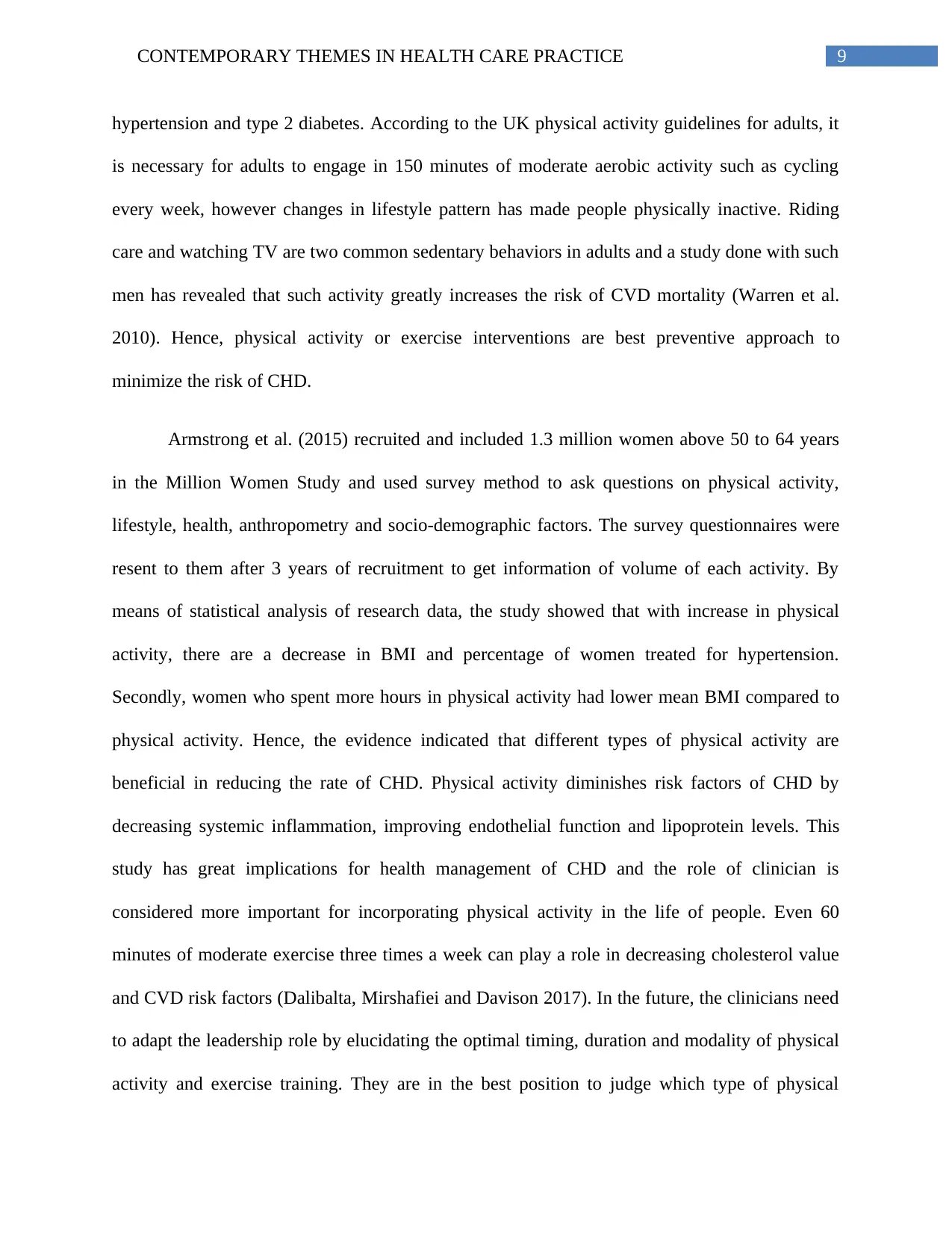
9CONTEMPORARY THEMES IN HEALTH CARE PRACTICE
hypertension and type 2 diabetes. According to the UK physical activity guidelines for adults, it
is necessary for adults to engage in 150 minutes of moderate aerobic activity such as cycling
every week, however changes in lifestyle pattern has made people physically inactive. Riding
care and watching TV are two common sedentary behaviors in adults and a study done with such
men has revealed that such activity greatly increases the risk of CVD mortality (Warren et al.
2010). Hence, physical activity or exercise interventions are best preventive approach to
minimize the risk of CHD.
Armstrong et al. (2015) recruited and included 1.3 million women above 50 to 64 years
in the Million Women Study and used survey method to ask questions on physical activity,
lifestyle, health, anthropometry and socio-demographic factors. The survey questionnaires were
resent to them after 3 years of recruitment to get information of volume of each activity. By
means of statistical analysis of research data, the study showed that with increase in physical
activity, there are a decrease in BMI and percentage of women treated for hypertension.
Secondly, women who spent more hours in physical activity had lower mean BMI compared to
physical activity. Hence, the evidence indicated that different types of physical activity are
beneficial in reducing the rate of CHD. Physical activity diminishes risk factors of CHD by
decreasing systemic inflammation, improving endothelial function and lipoprotein levels. This
study has great implications for health management of CHD and the role of clinician is
considered more important for incorporating physical activity in the life of people. Even 60
minutes of moderate exercise three times a week can play a role in decreasing cholesterol value
and CVD risk factors (Dalibalta, Mirshafiei and Davison 2017). In the future, the clinicians need
to adapt the leadership role by elucidating the optimal timing, duration and modality of physical
activity and exercise training. They are in the best position to judge which type of physical
hypertension and type 2 diabetes. According to the UK physical activity guidelines for adults, it
is necessary for adults to engage in 150 minutes of moderate aerobic activity such as cycling
every week, however changes in lifestyle pattern has made people physically inactive. Riding
care and watching TV are two common sedentary behaviors in adults and a study done with such
men has revealed that such activity greatly increases the risk of CVD mortality (Warren et al.
2010). Hence, physical activity or exercise interventions are best preventive approach to
minimize the risk of CHD.
Armstrong et al. (2015) recruited and included 1.3 million women above 50 to 64 years
in the Million Women Study and used survey method to ask questions on physical activity,
lifestyle, health, anthropometry and socio-demographic factors. The survey questionnaires were
resent to them after 3 years of recruitment to get information of volume of each activity. By
means of statistical analysis of research data, the study showed that with increase in physical
activity, there are a decrease in BMI and percentage of women treated for hypertension.
Secondly, women who spent more hours in physical activity had lower mean BMI compared to
physical activity. Hence, the evidence indicated that different types of physical activity are
beneficial in reducing the rate of CHD. Physical activity diminishes risk factors of CHD by
decreasing systemic inflammation, improving endothelial function and lipoprotein levels. This
study has great implications for health management of CHD and the role of clinician is
considered more important for incorporating physical activity in the life of people. Even 60
minutes of moderate exercise three times a week can play a role in decreasing cholesterol value
and CVD risk factors (Dalibalta, Mirshafiei and Davison 2017). In the future, the clinicians need
to adapt the leadership role by elucidating the optimal timing, duration and modality of physical
activity and exercise training. They are in the best position to judge which type of physical
Paraphrase This Document
Need a fresh take? Get an instant paraphrase of this document with our AI Paraphraser
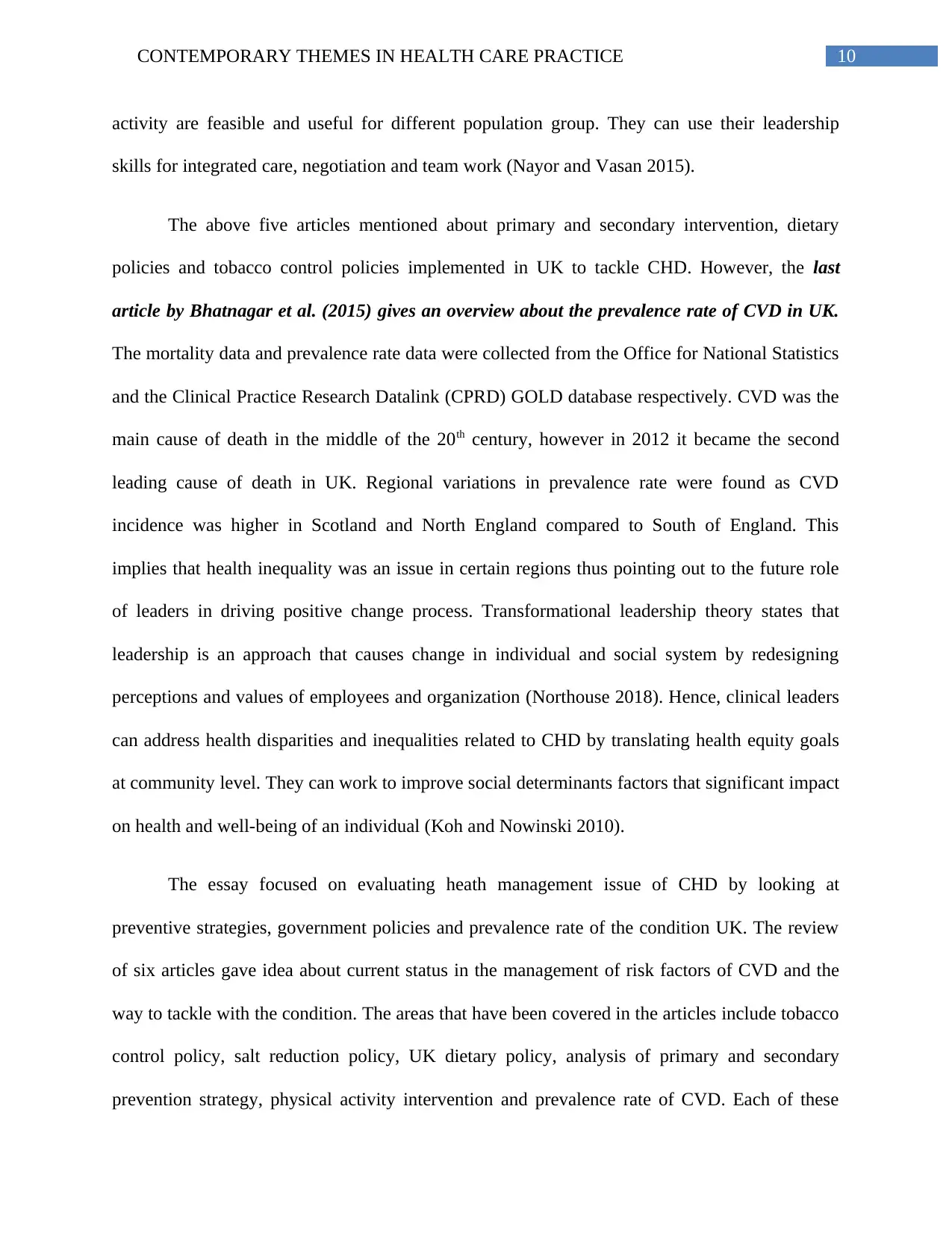
10CONTEMPORARY THEMES IN HEALTH CARE PRACTICE
activity are feasible and useful for different population group. They can use their leadership
skills for integrated care, negotiation and team work (Nayor and Vasan 2015).
The above five articles mentioned about primary and secondary intervention, dietary
policies and tobacco control policies implemented in UK to tackle CHD. However, the last
article by Bhatnagar et al. (2015) gives an overview about the prevalence rate of CVD in UK.
The mortality data and prevalence rate data were collected from the Office for National Statistics
and the Clinical Practice Research Datalink (CPRD) GOLD database respectively. CVD was the
main cause of death in the middle of the 20th century, however in 2012 it became the second
leading cause of death in UK. Regional variations in prevalence rate were found as CVD
incidence was higher in Scotland and North England compared to South of England. This
implies that health inequality was an issue in certain regions thus pointing out to the future role
of leaders in driving positive change process. Transformational leadership theory states that
leadership is an approach that causes change in individual and social system by redesigning
perceptions and values of employees and organization (Northouse 2018). Hence, clinical leaders
can address health disparities and inequalities related to CHD by translating health equity goals
at community level. They can work to improve social determinants factors that significant impact
on health and well-being of an individual (Koh and Nowinski 2010).
The essay focused on evaluating heath management issue of CHD by looking at
preventive strategies, government policies and prevalence rate of the condition UK. The review
of six articles gave idea about current status in the management of risk factors of CVD and the
way to tackle with the condition. The areas that have been covered in the articles include tobacco
control policy, salt reduction policy, UK dietary policy, analysis of primary and secondary
prevention strategy, physical activity intervention and prevalence rate of CVD. Each of these
activity are feasible and useful for different population group. They can use their leadership
skills for integrated care, negotiation and team work (Nayor and Vasan 2015).
The above five articles mentioned about primary and secondary intervention, dietary
policies and tobacco control policies implemented in UK to tackle CHD. However, the last
article by Bhatnagar et al. (2015) gives an overview about the prevalence rate of CVD in UK.
The mortality data and prevalence rate data were collected from the Office for National Statistics
and the Clinical Practice Research Datalink (CPRD) GOLD database respectively. CVD was the
main cause of death in the middle of the 20th century, however in 2012 it became the second
leading cause of death in UK. Regional variations in prevalence rate were found as CVD
incidence was higher in Scotland and North England compared to South of England. This
implies that health inequality was an issue in certain regions thus pointing out to the future role
of leaders in driving positive change process. Transformational leadership theory states that
leadership is an approach that causes change in individual and social system by redesigning
perceptions and values of employees and organization (Northouse 2018). Hence, clinical leaders
can address health disparities and inequalities related to CHD by translating health equity goals
at community level. They can work to improve social determinants factors that significant impact
on health and well-being of an individual (Koh and Nowinski 2010).
The essay focused on evaluating heath management issue of CHD by looking at
preventive strategies, government policies and prevalence rate of the condition UK. The review
of six articles gave idea about current status in the management of risk factors of CVD and the
way to tackle with the condition. The areas that have been covered in the articles include tobacco
control policy, salt reduction policy, UK dietary policy, analysis of primary and secondary
prevention strategy, physical activity intervention and prevalence rate of CVD. Each of these
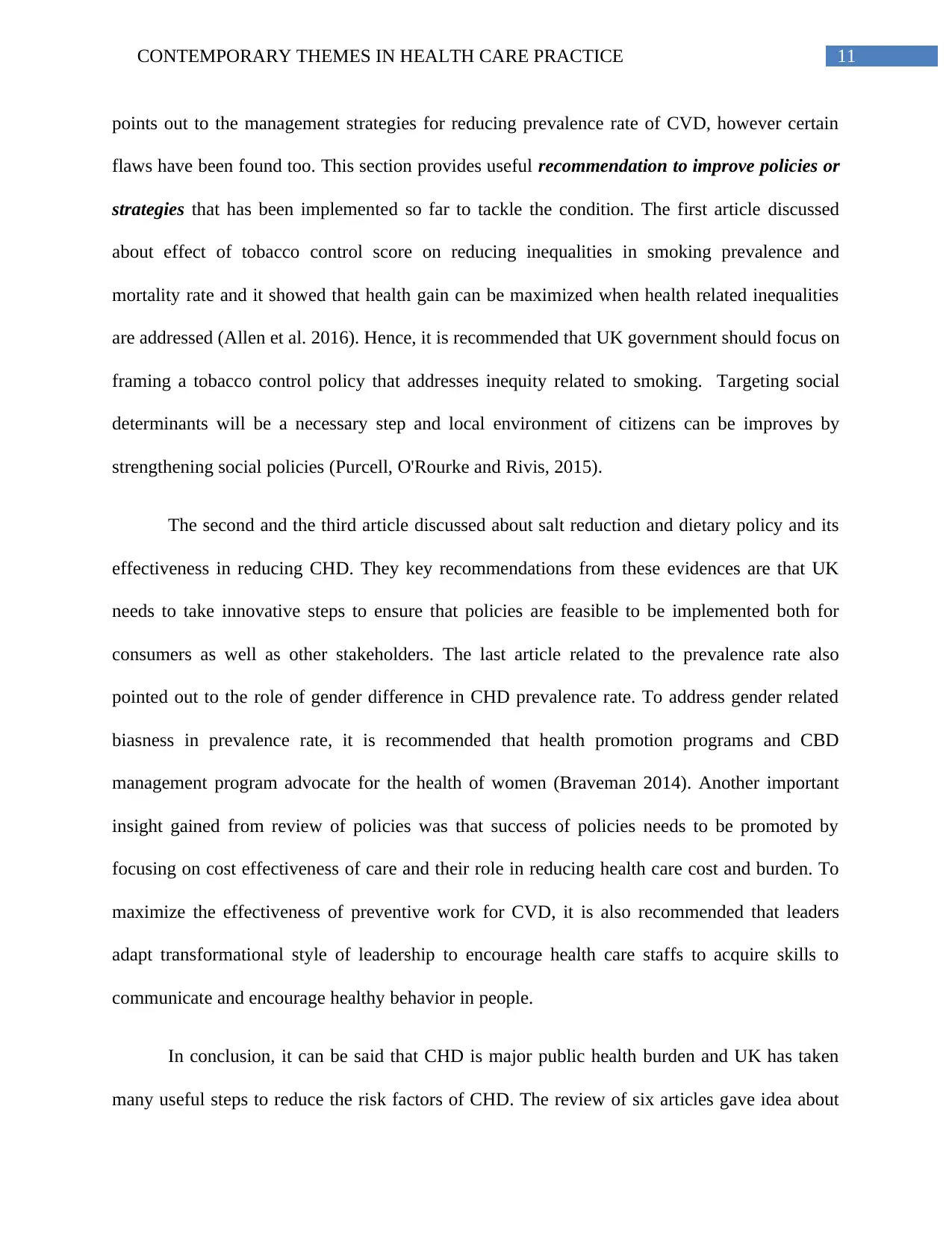
11CONTEMPORARY THEMES IN HEALTH CARE PRACTICE
points out to the management strategies for reducing prevalence rate of CVD, however certain
flaws have been found too. This section provides useful recommendation to improve policies or
strategies that has been implemented so far to tackle the condition. The first article discussed
about effect of tobacco control score on reducing inequalities in smoking prevalence and
mortality rate and it showed that health gain can be maximized when health related inequalities
are addressed (Allen et al. 2016). Hence, it is recommended that UK government should focus on
framing a tobacco control policy that addresses inequity related to smoking. Targeting social
determinants will be a necessary step and local environment of citizens can be improves by
strengthening social policies (Purcell, O'Rourke and Rivis, 2015).
The second and the third article discussed about salt reduction and dietary policy and its
effectiveness in reducing CHD. They key recommendations from these evidences are that UK
needs to take innovative steps to ensure that policies are feasible to be implemented both for
consumers as well as other stakeholders. The last article related to the prevalence rate also
pointed out to the role of gender difference in CHD prevalence rate. To address gender related
biasness in prevalence rate, it is recommended that health promotion programs and CBD
management program advocate for the health of women (Braveman 2014). Another important
insight gained from review of policies was that success of policies needs to be promoted by
focusing on cost effectiveness of care and their role in reducing health care cost and burden. To
maximize the effectiveness of preventive work for CVD, it is also recommended that leaders
adapt transformational style of leadership to encourage health care staffs to acquire skills to
communicate and encourage healthy behavior in people.
In conclusion, it can be said that CHD is major public health burden and UK has taken
many useful steps to reduce the risk factors of CHD. The review of six articles gave idea about
points out to the management strategies for reducing prevalence rate of CVD, however certain
flaws have been found too. This section provides useful recommendation to improve policies or
strategies that has been implemented so far to tackle the condition. The first article discussed
about effect of tobacco control score on reducing inequalities in smoking prevalence and
mortality rate and it showed that health gain can be maximized when health related inequalities
are addressed (Allen et al. 2016). Hence, it is recommended that UK government should focus on
framing a tobacco control policy that addresses inequity related to smoking. Targeting social
determinants will be a necessary step and local environment of citizens can be improves by
strengthening social policies (Purcell, O'Rourke and Rivis, 2015).
The second and the third article discussed about salt reduction and dietary policy and its
effectiveness in reducing CHD. They key recommendations from these evidences are that UK
needs to take innovative steps to ensure that policies are feasible to be implemented both for
consumers as well as other stakeholders. The last article related to the prevalence rate also
pointed out to the role of gender difference in CHD prevalence rate. To address gender related
biasness in prevalence rate, it is recommended that health promotion programs and CBD
management program advocate for the health of women (Braveman 2014). Another important
insight gained from review of policies was that success of policies needs to be promoted by
focusing on cost effectiveness of care and their role in reducing health care cost and burden. To
maximize the effectiveness of preventive work for CVD, it is also recommended that leaders
adapt transformational style of leadership to encourage health care staffs to acquire skills to
communicate and encourage healthy behavior in people.
In conclusion, it can be said that CHD is major public health burden and UK has taken
many useful steps to reduce the risk factors of CHD. The review of six articles gave idea about
⊘ This is a preview!⊘
Do you want full access?
Subscribe today to unlock all pages.

Trusted by 1+ million students worldwide
1 out of 17
Related Documents
Your All-in-One AI-Powered Toolkit for Academic Success.
+13062052269
info@desklib.com
Available 24*7 on WhatsApp / Email
![[object Object]](/_next/static/media/star-bottom.7253800d.svg)
Unlock your academic potential
Copyright © 2020–2025 A2Z Services. All Rights Reserved. Developed and managed by ZUCOL.




